�
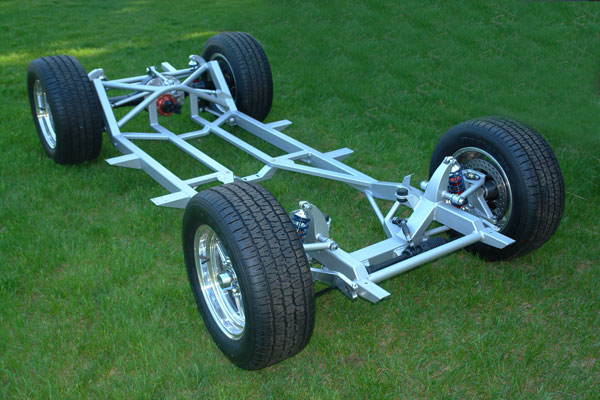
�
Fast Cars Offers New and Improved Chassis for Triumph TR6
� as published in BritishV8 Magazine, Volume XVII Issue 1, July 2009�� by: Curtis Jacobson�
�
�
Fast Cars' latest offering will excite Triumph TR6 enthusiasts and�
probably kit car builders too! �
�
Fast Cars has begun selling replacement TR6 chassis that include entirely �
redesigned suspensions with coil-over shock absorbers and Wilwood disc brakes, �
front and rear. The core of the chassis design is a tubular frame that easily�
surpasses the original TR6 frame in both strength and rigidity. �
�
Original TR6 bodies will bolt right on, using existing body mounting points. �
(With some modifications, this chassis can be used under other bodies as well.) �
�
In standard configuration, the chassis is designed to accept a Ford 302 V8 �
with a T5 5-speed transmission, but other options will be available on a �
made-to-order basis. A lightweight but tough Ford 8" rear axle is �
standard equipment. �
�
�
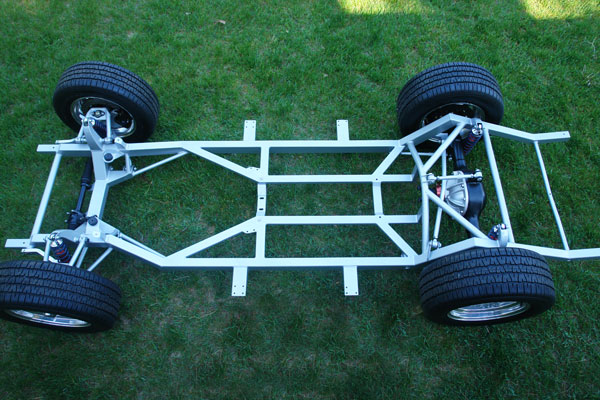
�
The Frame
��
Fast Cars' new TR6 frame is primarily constructed of mild steel "box" tubing.�
A handful of crossmembers and braces have round cross-sections, but they're�
the exceptions that prove the rule. The practical advantage of this is that �
it will always be easy to modify or repair the frame, and specifically it �
will be easy to install various brackets and accessories. �
�
The frame comes standard with motor mounts suitable for a Ford 302 V8 engine�
and with transmission mounts for a Borg Warner (or Tremec) T5 5-speed �
transmission. However, if you prefer a different engine or transmission,�
Fast Cars will be happy to assist you. If you'd like to supply your engine, �
they'll even be happy to engineer mounts for it and install them in their �
shop. Don't hesitate to call for an estimate, and to discuss your specific �
application. �
�
Installing a body can be tricky. Fast Cars will also be happy to provide �
assistance at this stage of your project. Contact them to discuss your specific �
needs, whether you're working with a pristine, Heritage TR6 bodyshell or �
considering building a one-of-a-kind body. Since Fast Cars TR6 frames are made �
to order, they can easily alter where body brackets are installed along the �
frame. �
�
Want a roll hoop or a full rollcage? Fast Cars can help you with that too. �
�
Various paint finishes are available, including custom colors.�
�
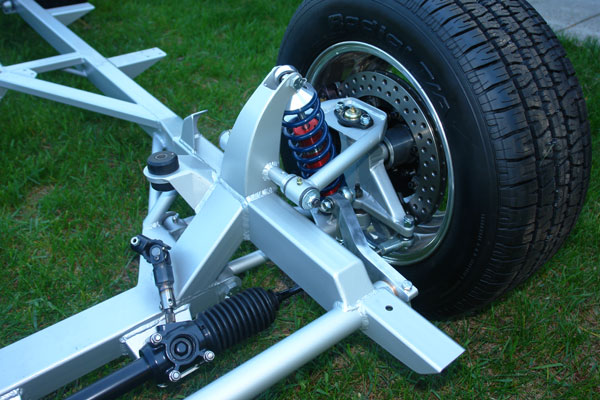
�
The Front Suspension
��
The first priority of the front suspension design was to minimize un-sprung weight. �
Whereas any weight reduction will make a car quicker, reduction of un-sprung weight �
particularly improves ride quality. To this end, the front suspensionf features �
fabricated 4130N spindles, aluminum alloy (6061) hubs, and Timken tapered roller �
bearings. The spindle assemblies weigh just 5 pounds 2 ounces each (without brakes). �
The brakes are 11.75" Wilwood vented rotors with robust four-pot Wilwood "Dynalite" �
aluminum brake calipers. Nylatron GS bushes are used at the suspension pivots.�
�
Another design priority was to further improve ride quality and handling thru better �
placement of the lower spring mounting point. The lightweight QA1 aluminum-bodied �
coil-over shocks are mounted quite far out at the lower end, so the springs compress �
relatively far for any given wheel displacement. This increases piston travel for �
any given bump, which is advanteous. The coil-over shock absorbers also facilitate �
very simple ride height and corner weight adjustment. �
�
The Fast Cars IFS has a nominal caster angle of three degrees, and like modern cars �
caster can be easily fine-tuned during alignment. The adjustment range is �
2.5 to 5.0 degrees. The Fast Cars IFS is also designed to have very little static �
camber. (Camber is the relative angle of the steering pivot axis to a vertical line �
as viewed from the front or rear of the car. It changes with body roll as a function �
of suspension geometry. Better tire life and straight-line braking are also benefits �
of utilizing less static camber.) Ted recommends very little toe-in: just one �
thirty-secondth to one sixteenth of an inch.�
�
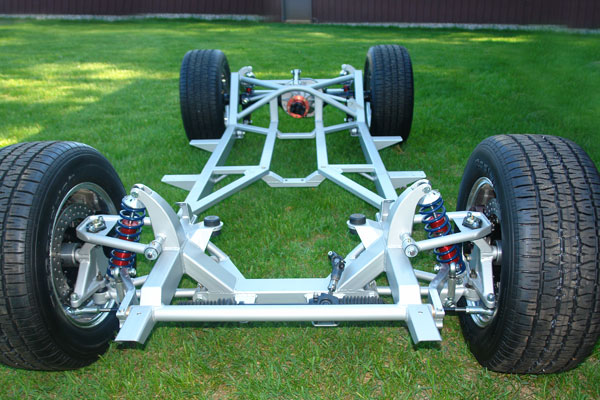
�
�
By virtue of the relative placement of A-arm attachment points, the Fast Cars front �
suspension has some "anti-dive" built in. The suspension geometry has been engineered�
so that the upward force of brake torque reaction partially counteracts the downward �
force of load transfer. �
�
One of the distinctive characteristic of Fast Cars front suspensions is light, �
precise steering. This is partly attributable to suspension geometry. It's also partly �
because of the steering rack that Fast Cars uses, which is custom made to their �
specifications. Of course, the steering requires an intermediate shaft and u-joints�
to connect to the TR6 steering column. Customers can fabricate their own, or they �
can buy a custom-made intermediate shaft from Fast Cars. �
�
Wider track width versions of the suspension are available for customers who are �
fitting fender flares. �
�
Since hubs are made to order, they're available with whatever popular four or five�
hole lug spacing you prefer. Of course, your preference may depend on what wheels�
you plan to use. �
�
Fast Cars' proprietor, Ted Lathrop, has earned quite a reputation for inventing trick�
construction details. One of our favorite details of the new chassis is the way the �
front anti-sway bar is housed within a tubular crossmember. Its lightweight aluminum �
arms are splined to match the steel bar, and they can easily be removed if a stiffer �
or softer bar is desired.�
�
Enjoying this article? Our magazine is funded through the generous support of readers like you!
�
To contribute to our operating budget, please click here and follow the instructions.
�
(Suggested contribution is twenty bucks per year. Feel free to give more!)�
�
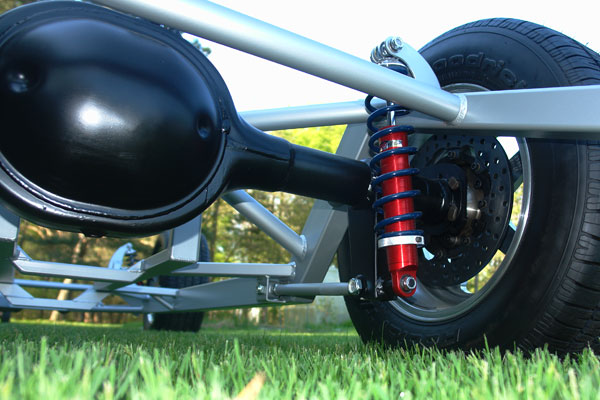
�
The Rear Suspension
��
The Fast Cars TR6 chassis comes with a Ford 8" live axle, Wilwood disc brakes, �
and a custom "three-link" coil-over rear suspension. The nomenclature here can �
be a little confusing, so to be clear: a three-link rear suspension is actually �
composed of four links, plus two coilover shock absorbers. The three links that �
extend forward locate the axle forward-to-back and restrict its rotation (e.g. �
pinion angle). The two bottom links run forward from brackets underneath the �
axle, parallel with each other. This is a nice feature because it simplifies �
suspension alignment. The third link runs forward from the top of the differential �
housing. The fourth link is a Panhard rod; it locates the axle side-to-side. �
�
The coil-over shocks are located behind the axle, mounted straight up and down, �
and the Panhard rod is located in front of the axle. Therefore, to clear the axle �
pinion, the Panhard rod has a bend in it. The rear suspension geometry features �
"anti-squat". In other words, rearward weight transfer under acceleration is turned �
more efficiently into increased traction.�
�
Nylatron "GS" bushings are used at the ends of the radius rods in lieu of �
Heim joints (which would transmit more road noise and would probably wear out �
quicker) or rubber bushings.�
�
The axle itself is brand new, not just an old axle that has been "narrowed".�
The axle features an aluminum gear carrier ("pumpkin"), which is both lighter and �
cooler running than the iron alternative. The axle also comes with an Auburn limited �
slip differential.�
�
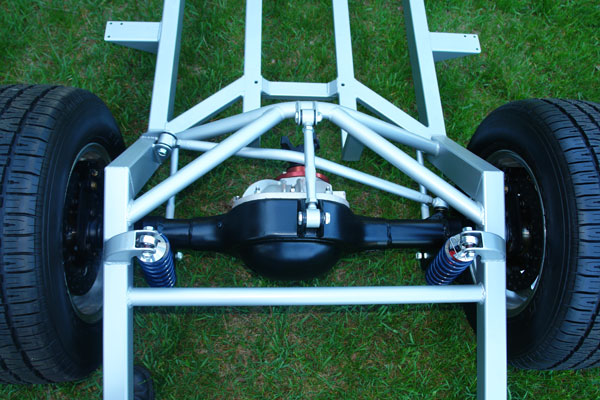
�
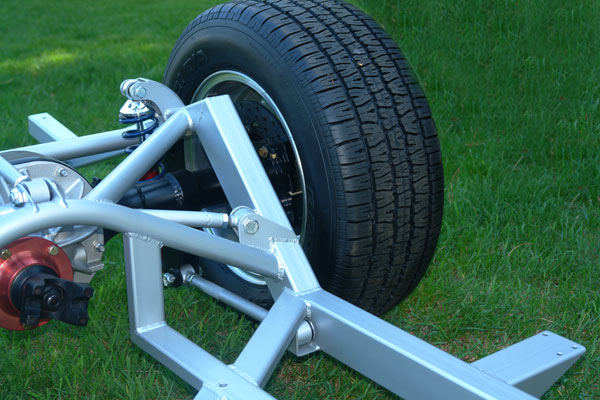
�
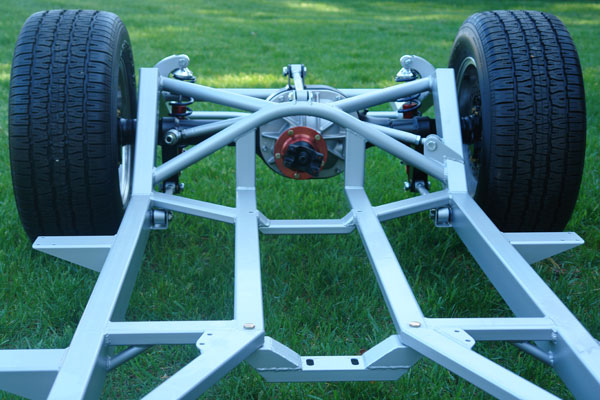
�
Additional Photos
��
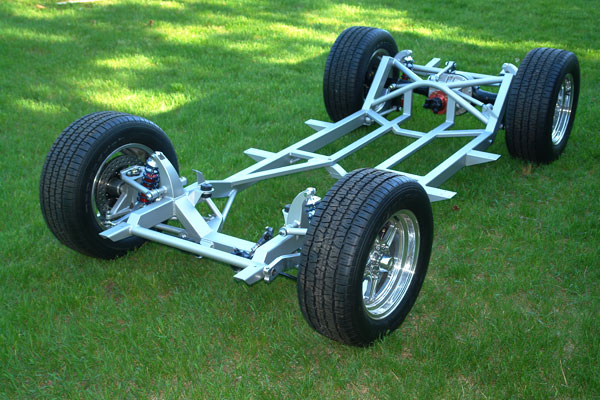
�
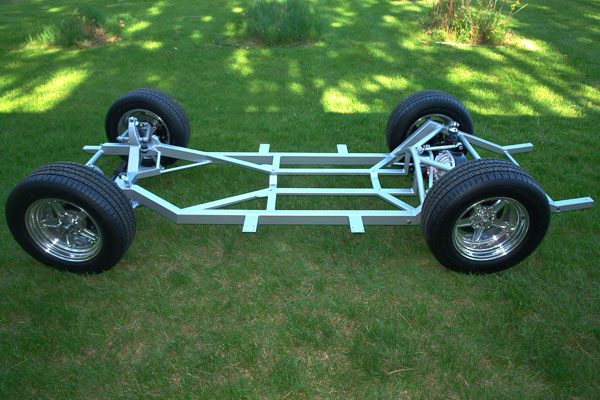
�

�
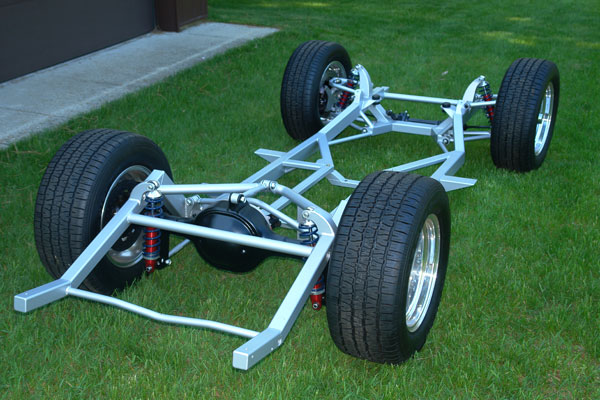
�
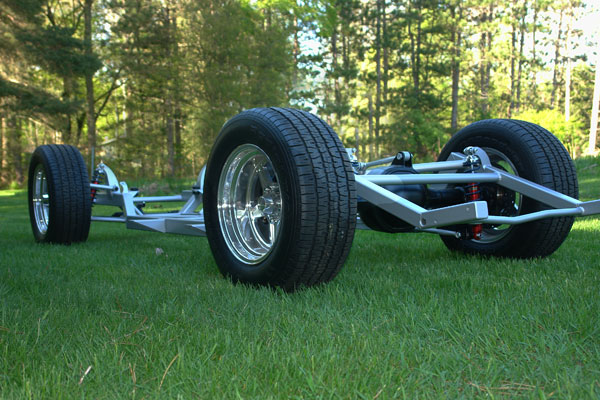
�
� Photographs by Wayne Edwards for BritishV8 Magazine. All rights reserved.�
�


